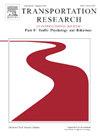城市隧道分流区驾驶行为惯性:基于任务转换视角的新发现
IF 3.5
2区 工程技术
Q1 PSYCHOLOGY, APPLIED
Transportation Research Part F-Traffic Psychology and Behaviour
Pub Date : 2025-02-01
DOI:10.1016/j.trf.2025.01.025
引用次数: 0
摘要
城市隧道分流区对提高整体交通效率至关重要。然而,驾驶任务的复杂性和驾驶员对这些任务的不准确的感知和反应是造成事故的主要原因。本研究将隧道分流区划分为三个任务段:进场段、匝道发现段、入口和导航段,并在分段过渡期间进行任务切换。目的是了解驾驶员对驾驶任务的反应和任务切换过程中的行为,为不同区域的交通工程优化提供依据。在现场测试中收集了44名驾驶员的速度、纵向加速度、车辆位置和方向盘角度数据。首先,对任务段内的驾驶行为进行了比较分析。然后使用方差分析来确定任务切换期间每个指标的关键变化点。最后,采用K-means聚类分析多个驾驶行为指标,探索任务转换过程中的响应延迟。结果表明,驾驶员在任务段内表现出较高的超速比和延迟变道反应。在任务切换过程中,驾驶员倾向于继续其先前的驾驶状态,即“驾驶行为惯性”,导致驾驶员进入减速车道的时间较晚,并且减速更为突然,这突出表明驾驶员在隧道分流区域的任务敏感性降低,风险感知降低。此外,驾驶行为惯性受路线和性别的影响显著。左车道驾驶员的惯性弱于右车道驾驶员,而女性驾驶员的惯性强。研究结果为隧道分流区交通工程设施的设计与优化提供了有价值的参考。本文章由计算机程序翻译,如有差异,请以英文原文为准。
Driving behavior inertia in urban tunnel diverging areas: New findings based on task-switching perspective
Urban tunnel diverging areas are crucial for enhancing overall traffic efficiency. However, the complexity of driving tasks and drivers’ inaccurate perception and response to these tasks are primary contributors to accidents. This study categorizes tunnel diverging areas into three task segments: the approach segment, ramp discovery segment, and entry and navigation segment, with task switching occurring during segment transitions. The objective is to investigate drivers’ responses to driving tasks and their behavior during task switching, providing a foundation for optimizing traffic engineering in diverging areas. Data on speed, longitudinal acceleration, vehicle position, and steering wheel angle were collected from 44 drivers in field tests. Initially, a comparative analysis of driving behavior within task segments was conducted. ANOVA was then used to identify critical change points for each indicator during task switching. Finally, K-means clustering was employed to analyze multiple driving behavior indicators and explore response delays during task transitions. The results reveal that drivers exhibited a higher speeding ratio and delayed lane-change responses within task segments. During task switching, drivers tended to continue their previous driving state—termed ‘driving behavior inertia’, which led to later entries into deceleration lanes and more abrupt deceleration, highlighting drivers’ reduced task sensitivity and lower risk perception in tunnel diverging areas. Furthermore, driving behavior inertia was significantly influenced by route and gender. Drivers in the left lane showed weaker inertia than those in the right lane, while female drivers exhibited stronger inertia. These findings offer valuable insights for the design and optimization of traffic engineering facilities in tunnel diverging areas.
求助全文
通过发布文献求助,成功后即可免费获取论文全文。
去求助
来源期刊
CiteScore
7.60
自引率
14.60%
发文量
239
审稿时长
71 days
期刊介绍:
Transportation Research Part F: Traffic Psychology and Behaviour focuses on the behavioural and psychological aspects of traffic and transport. The aim of the journal is to enhance theory development, improve the quality of empirical studies and to stimulate the application of research findings in practice. TRF provides a focus and a means of communication for the considerable amount of research activities that are now being carried out in this field. The journal provides a forum for transportation researchers, psychologists, ergonomists, engineers and policy-makers with an interest in traffic and transport psychology.

 求助内容:
求助内容: 应助结果提醒方式:
应助结果提醒方式:


